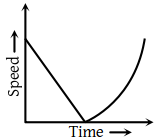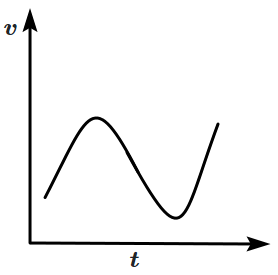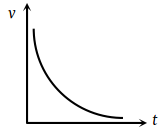A ball is thrown vertically upwards. Which of the following plots represents the speed-time graph of the ball during its height if the air resistance is not ignored?
1.

2.

3.

4.





Which graph represents a uniformly accelerated motion?
| 1. |  |
2. |  |
| 3. |  |
4. |  |
Which of the following velocity-time graphs shows a realistic situation for a body in motion?
| 1. |  |
2. |  |
| 3. |  |
4. |  |
Which of the following velocity-time graphs represent uniform motion.
| 1. |  |
| 2. |  |
| 3. |  |
| 4. |  |
Acceleration-time graph of a body is shown.
The corresponding velocity-time graph of the same body is:
| 1. |  |
2. |  |
| 3. |  |
4. |  |
The acceleration-time graph of a body is shown below.
The most probable velocity-time graph of the body is
| 1. |  |
| 2. |  |
| 3. |  |
| 4. |  |
The v – t plot of a moving object is shown in the figure. The average velocity of the object during the first 10 seconds is
1. 0
2. 2.5 ms–1
3. 5 ms–1
4. 2 ms–1
Read the assertion and reason carefully to mark the correct option out of the options given below:
(1) If both assertion and reason are true and the reason is the correct explanation of the assertion.
(2) If both assertion and reason are true but reason is not the correct explanation of the assertion.
(3) If assertion is true but reason is false.
(4) If the assertion and reason both are false.
(5) If assertion is false but reason is true.
Assertion : Two balls of different masses are thrown vertically upward with same speed. They will pass through their point of projection in the downward direction with the same speed.
Reason : The maximum height and downward velocity attained at the point of projection are independent of the mass of the ball.
Read the assertion and reason carefully to mark the correct option out of the options given below:
(1) If both assertion and reason are true and the reason is the correct explanation of the assertion.
(2) If both assertion and reason are true but reason is not the correct explanation of the assertion.
(3) If assertion is true but reason is false.
(4) If the assertion and reason both are false.
(5) If assertion is false but reason is true.
Assertion : The average velocity of the object over an interval of time is either smaller than or equal to the average speed of the object over the same interval.
Reason : Velocity is a vector quantity and speed is a scalar quantity.
Read the assertion and reason carefully to mark the correct option out of the options given below:
(1) If both assertion and reason are true and the reason is the correct explanation of the assertion.
(2) If both assertion and reason are true but reason is not the correct explanation of the assertion.
(3) If assertion is true but reason is false.
(4) If the assertion and reason both are false.
(5) If assertion is false but reason is true.
Assertion : An object can have constant speed but variable velocity.
Reason : Speed is a scalar but velocity is a vector quantity.









